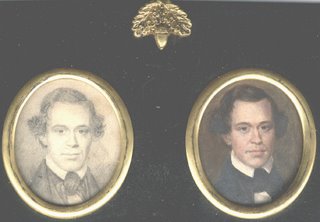 This pair of miniature portraits in a single frame, one being preliminary sketch, are by Levi North. The artist has not been identified and may be British. On the reverse of the left hand portrait is written "By Levi North .... 1842 - No 377" and on the reverse of the right hand portrait is written "2 March 1842".
This pair of miniature portraits in a single frame, one being preliminary sketch, are by Levi North. The artist has not been identified and may be British. On the reverse of the left hand portrait is written "By Levi North .... 1842 - No 377" and on the reverse of the right hand portrait is written "2 March 1842".A review of men named Levi North in the 1850 USA and 1851 England census records has not located an artist of this name. However, a possible candidate is the Levi North who was a watchmaker in New York in the 1850 census. He was then aged 29 and was born in NY. The sitter is unknown. 462
An eBay vendor has kindly posted the information below about Levi North.
This stampless letter was written by David McCord Anderson on January 1, 1843 from Hamilton Township, Franklin County, Pennsylvania and sent to Hannah Jane Hamill of Mt. Vernon Post Office, Knox County, Ohio. This is a lengthy letter of 3+ pages. Although the content is quite interesting, the best part is this:
I have your hair yet that was left of your necklace but I haven't braided it yet. I would like to have your portrait to look at if you could send it in a letter. Perhaps you could get a small one drawn by Levi North.
Levi North is an unlisted artist; he is not listed in New York Historical Society's Dictionary of Artists in America, 1564-1860. In fact, he is not listed in any of the books I own. In other words, he is one of those rare forgotten artists. From what I could gather Levi North was a portrait painter, lawyer and an abolitionist. He even debated about slavery with Abraham Lincoln on one occasion (see below for details from History of Henry County, Illinois, Volume I By Henry L. Kiner, 1910).
Levi North, a Kewanee lawyer, was a man of strong individuality. He was born at Turin, Lewis county, New York, March 12, 1821. North's ambitions in youth were artistic. For many years he plied the brush and was uneasy without his easel. It is said that he was a clever painter. He became interested in law, and applied himself to the study thereof, as a side issue. Painting would be his vocation, law his avocation. But the gods willed otherwise. The above order was reversed. His education was limited to the log-cabin schools of early days, with possibly a few months at a little academy at Louisville , N. Y., before he was 16 years of age. Just what accident led to the discovery that he really possessed a talent for drawing, does not appear; but certain it is that with opportunity he would have made his mark in the field of fine arts. As it was, he practiced more or less at the easel, doing some portraits with creditable success, and finally, when about 18 years of age, determined to abandon everything else and devote his time to art. He was financially poor, untaught and untraveled, and the undertaking was a great one. He took his studies from life, not having the benefit of a reputably good painting before he was 20 years of age.
However, like many another man who has achieved greatness by not knowing of nothing to discourage him, he itinerated from place to place, borrowed what books he could and read them; painted the images of the handsomest styles, made himself popular with respectable and intelligent people and absorbed altogether a pretty wide range of ideas. One incident above all others in North's long life, stood out vividly in the backward bearing mirror of his memory. In 1848 he made a trip on the great lakes, in the good ship "Globe." To while away the weary hours, a political debate in the cabin was planned. The subject was slavery. North was at home on that subject. He was one of the most absolute abolitionists in the country. The "Globe" trembled with the white hot lightnings of his oratory. Then a slavery man tried to make a case of his abhorrent doctrine. The master of ceremonies introduced as the next speaker against slavery, a member of congress from Illinois. He was a tall, awkward, shambling man, with high cheek bones, and an eye that glowed with fire, or twinkled with irrestible fun. And his name was Abraham Lincoln. This letter is important as it pinpoints North's working location. In addition, it confirms that North did portraits. There is a good chance North did a portrait of Hannah Jane Hamill as well. Someone may own it as an unattributed artist's work. At any rate, this letter is a first-hand account of a very overlooked artist. Because of this new find, we can confidently attribute the work posted above in the miniature portrait blog.



No comments:
Post a Comment